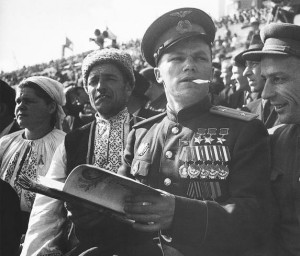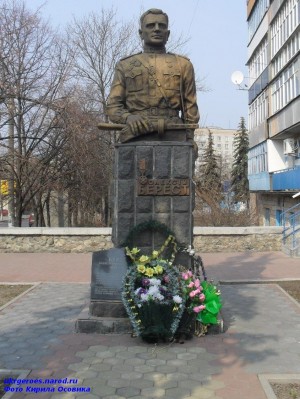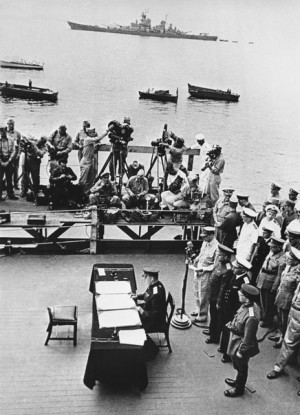Would the Russians have defeated Germany even without the assistance of the Ukrainians?
| Myths and Stereotypes | Historical Reality |
The Russians would have defeated Germany even without the assistance of the Ukrainians.The main burden of the war was borne by the Russians themselves. |
Almost 70 years after the conclusion of the Second World War, Russian propaganda in every possible way downplays the contribution of other former Soviet republics in the victory over Nazism. Only Russians exclusively are acknowledged and hailed as the victors. Ukrainians in Russian propaganda are viewed exclusively as “collaborationists and “Nazi sympathizers.” But is this so? Close to 7 million citizens of Ukraine fought in the ranks of the Red Army, in other words approximately 23% of the overall number of troops who served in the Armed Forces of the USSR. The Red Army’s overall losses constituted 8–9 million individuals, and of these 3.5–4 million were Ukrainians. Ukraine’s overall military losses amounted to virtually half of Germany’s losses and its western allies, put together. The irreversible demographic losses of the Ukrainian S.S.R.’s population comprised 13–14 million people. Ukrainians also fought in armies of other participatory states of the anti-Hitler coalition.Before answering this question, we should assess when and how did the myth about the notion that the Russian people bore the principal burden of the war come about. The issue regarding the contribution of lives for the victory over Nazism is tightly intertwined with the amount of losses suffered over the course of the entire war. Let us begin with the fact that the question regarding the number of losses of the USSR’s population in the “Great Patriotic War” continues to be a subject of debate. In the 1960s, the official figure came to 20 million people. Over time, M. Gorbachev announced information amounting to 27 million individuals dying, while some contemporary researchers place the figure at 32 million people. The truth is buried somewhere in Moscow’s archives. The Russian Version According to data made available by the Russian group of military historians headed by Gen. H. Kryvosheyev, during the years of the “Great Patriotic War” (1941–45), close to 34.5 million Soviet citizens fought in the ranks of the Red Army and Navy. Irreversible losses amounted to 8,688,400 individuals. Of these, 1,376,000 were Ukrainians (or 15.9% of the overall number of the USSR’s military losses). (See: Pamyati pavshykh. Velikaya Otechestvennaya Woina. 1941-1945 [To the Memory of the Fallen. The Great Patriotic War. 1941-1945]. Moscow, BRE, 1995, p. 335). However, everything depends on how the figures are calculated, e.g., by ethnicity or territorial variables. Since Ukraine has always been a multinational state, the current methodology as well as the motives for its use, leaves much to be desired. Moreover, for Ukrainians, the war began not in 1941, but rather 1 September 1939, which also needs to be taken into account. This includes as participants of military actions those Ukrainians who were citizens of Poland as well soldiers in Polish detachments, who fought on the numerous frontlines of World War II. The methodology of Kryvosheyev’s group involved the use of the ethnic variable and automatically disregarded the citizens of other nationalities (Russians, Belarusians, Poles, Jews, Germans, Tartars, Moldovans, Armenians, Greeks, etc.), who for many generations lived in Ukraine, and for whom this land was their native territory. If one employs such a method for collecting statistical data, then logic would suggest that Kazakhstan—which during the prewar years was transformed into an area for deportation and exile, prisons and camps—suffered the least number of military losses, only 130,000 individuals (or 1.5% of the overall number of the USSR’s losses). However, the actual figure is twice the reported amount. Thus, Kryvosheyev’s data gathering procedure reduces the amount of losses of non-Russian peoples by 33.7%. The Ukrainian version Unfortunately, Ukrainian historians are unable to work with accurate figures for two reasons:
Nevertheless, a slew of statistical approaches do allow historians to make certain approximations. According to these methods, close to 7 million citizens of Ukraine fought in the ranks of the Red Army, in other words, 23% of the overall amount of individuals serving in the Armed Forces of the USSR. During the first phase of the war (prior to the occupation of Ukraine) 3.5 million individuals from the Ukrainian S.S.R. were conscripted into the ranks of the Red Army. And following Ukraine’s liberation from German occupation, another 3.6 million individuals were drafted into the Red Army, in other words 1/5 or 1/6 of the overall amount of those who fought in the Red Army. The number of Ukrainian citizens serving in the Red Army was constantly changing. In 1941, Ukrainians constituted 15-20% (second to the Russians) of those in the Red Army. Afterwards, in 1942, when many Red Army soldiers became prisoners of war and the Ukrainian S.S.R. became occupied, the numbers dropped drastically. However, already by early 1944, during the liberation of Ukraine, the number of Ukrainians in the Red Army grew by more than 22%. The Red Army’s overall losses amounted to 8-9 million individuals, and of these, 3.5–4 million were Ukrainians. If one takes into account the irreversible military losses of Germany and its western allies in total (Italy, Hungary, Romania, Finland and the Wehrmacht’s ethnic detachments; a sum totaling 8,649,500 individuals), then in comparison, Ukraine’s overall military losses constitute virtually half of Germany’s losses and those of its allies, put together. 
For their military service in the Great Patriotic War, close to 2.5 million Ukrainians were awarded various orders and medals. For exceptional valor, 2,000 Ukrainian soldiers were bestowed with the title of Hero of the Soviet Union. I. Kozhedub was awarded the title of Hero of the Soviet Union three times. Thirty two Ukrainians were awarded this title twice, including A. Molodchyi, D. Hlinka, P. Taran, M. Bondarenko, A. Mazurenko, A. Nedbaylo, V. Mykhlyk and others. Many Ukrainians served in the Red Army’s High Command as well: H. Kulyk, S. Tymoshenko, I. Cherniakhivsky, A. Hrechko, A. Yeremenko, K. Moskalenko, P. Zhmachenko, R. Malynovsky. Ukrainians were also extensively represented in the Soviet partisan movement. One of the signatories of the Act of the Surrender of Japan was Ukrainian general K. Derevyanko. The first to raise the flag of victory over the Reichstag was the Ukrainian Oleksiy Berest. Soon afterwards, for political reasons, Berest’s persona was downplayed by the Soviet leadership, while M. Yegorov and M. Kantaria became the main heroes. Moreover, Ukrainian S.S.R. membership in the UN as a founding state came to serve as international recognition of the Ukrainians’ contribution in the defeat over Nazism. Civilian losses, economic and cultural devastationIn 1941, the population of Ukraine comprised 41,657,000 people, whereas in 1945 it equaled only 27–28 million individuals. As a result, irreversible demographic losses of the population amounted to 13–14 million people, of which 3.5–4 million were soldiers of the Red Army, while the lion’s share of the losses fell upon the civilian population. As a result of military operations, 714 bridges, 28,000 villages and 419,000 manufacturing plants were destroyed. In addition, the occupants expropriated and shipped abroad 330,000 items of fine art, historical relics and various collections. From the territory of Ukraine, 2.4 million people were deported to Germany for slave labor. For safety and security purposes, from Ukraine close to 3.5 million citizens of the republic, 550 commercial enterprises, 70 institutions of higher education, 40 theaters and dozens of museums were evacuated to secret locations abroad. Finally, the following information is for those who prefer the ethnic variable in gauging the Ukrainians’ contribution in the victory over the Nazis. At the outset of the Second World War, close to 106–112 thousand (120–150 thousand according to some sources) ethnic Ukrainians served in the Polish Army, which at that time consisted of 1 million troops. During the September 1939 campaign, 8,000 Ukrainians as citizens of Poland lost their lives in combat against the Nazis. Ukrainians fought in the armies of the alliesIn contrast to Ukrainian service in the ranks of the Wehrmacht and SS troops, the fact that Ukrainians fought in the armies of the Allies is insufficiently researched (See: Ukrainians were “champions” of collaborationism?). Among the American troops who took part in Operation Overlord (the landings of the Allied troops on the Normandy coast of France), 40,000 were Americans of Ukrainian descent. The number of Ukrainians in the Canadian Army, according to different sources, amounted to between 35 and 50 thousand individuals, of which 11.4% were volunteers. Beginning in 1940, 5,000 Ukrainians fought in the French Foreign Legion. In 1944, the French Resistance established three separate Ukrainian detachments—the I. Bohun Battalion, the T. Shevchenko Battalion and the Lieutenant Krukovsky Division—comprised of defectors from the “Schutzmannschaften” (auxiliary police) and the training camp of the Galician (“Galizien”) Division of the Waffen-SS. A significant number of Ukrainians were drafted into the Polish and Czechoslovakian military formations created on the territory of the USSR. Thousands of ethnic Ukrainians—as former Polish citizens who had been deported to the eastern oblasts of the USSR after 1939—volunteered for service in the 2nd Polish Corps under the command of Gen. V. Anders. In 1942, this corps was transferred from the USSR and passed under the command of British expeditionary forces to take part in military campaigns in Egypt and the Middle East. In addition, the corps saw combat at the Battle of Monte Cassino (Italy), which is often referred to as the “Italian Stalingrad.” The battle lasted for half a year—January to May 1944. Over the course of the battle, 50,000 allied troops lost their lives, and of these losses the 2nd Polish Corps suffered 924 dead and 4,199 injured. These figures comprised more than 10% of the corp’s composition and 1/3 of its total losses over the duration of the war. The formation of the 1st Czechoslovak Independent Brigade under the command of Col. L. Svoboda was completed in the summer of 1943. Of the 15,000 troops, 11,000 were Ukrainians from the Transcarpathian region of Ukraine. (See: Mukovs’kyi I.T., Lysenko O.Ye. Zvytyaha i zhertovnist’: Ukraintsi na frontakh Druhoi svitovoi viiny / Za red. V.D.Konashevych [Mukovsky, I.T., Lysenko, O. Ye. Triumph and Sacrifice: Ukrainians on the Frontlines of the Second World War / Edited by V.D. Konashevych]. Kyiv: The Investigative Publishing Agency: “Knyha Pamiati Ukrainy,” 1996, 568 pp.). Let us not forget about the UPA (Ukrainian Insurgent Army), which also fought against the Germans. However, this example may not be entirely appropriate, given the fact that —despite the overwhelming number of Ukrainians—this military formation included representatives of other nationalities among its ranks. See: The “Banderites” never fought alongside the Germans? |


 Українська
Українська Русский
Русский